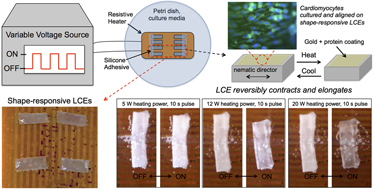Crossref Citations
This article has been cited by the following publications. This list is generated based on data provided by
Crossref.
Herrera-Posada, Stephany
Mora-Navarro, Camilo
Ortiz-Bermudez, Patricia
Torres-Lugo, Madeline
McElhinny, Kyle M.
Evans, Paul G.
Calcagno, Barbara O.
and
Acevedo, Aldo
2016.
Magneto-responsive liquid crystalline elastomer nanocomposites as potential candidates for dynamic cell culture substrates.
Materials Science and Engineering: C,
Vol. 65,
Issue. ,
p.
369.
Agrawal, Aditya
Chen, Huiying
Kim, Hojin
Zhu, Bohan
Adetiba, Oluwatomiyin
Miranda, Andrea
Cristian Chipara, Alin
Ajayan, Pulickel M.
Jacot, Jeffrey G.
and
Verduzco, Rafael
2016.
Electromechanically Responsive Liquid Crystal Elastomer Nanocomposites for Active Cell Culture.
ACS Macro Letters,
Vol. 5,
Issue. 12,
p.
1386.
Poulin, Alexandre
Saygili Demir, Cansaran
Rosset, Samuel
Petrova, Tatiana V.
and
Shea, Herbert
2016.
Dielectric elastomer actuator for mechanical loading of 2D cell cultures.
Lab on a Chip,
Vol. 16,
Issue. 19,
p.
3788.
Ponniah, J. K.
Chen, H.
Adetiba, O.
Verduzco, R.
and
Jacot, J. G.
2016.
Mechanoactive materials in cardiac science.
Journal of Materials Chemistry B,
Vol. 4,
Issue. 46,
p.
7350.
Zhou, Jing
and
Sheiko, Sergei S.
2016.
Reversible shape‐shifting in polymeric materials.
Journal of Polymer Science Part B: Polymer Physics,
Vol. 54,
Issue. 14,
p.
1365.
Koçer, Gülistan
ter Schiphorst, Jeroen
Hendrikx, Matthew
Kassa, Hailu G.
Leclère, Philippe
Schenning, Albertus P. H. J.
and
Jonkheijm, Pascal
2017.
Light‐Responsive Hierarchically Structured Liquid Crystal Polymer Networks for Harnessing Cell Adhesion and Migration.
Advanced Materials,
Vol. 29,
Issue. 27,
Téllez, Marco De Jesús
Navarro-Rodríguez, Dámaso
and
Larios-Lopez, Leticia
2017.
Synthesis of vinyl-functionalized azobenzene mesogens and study of their liquid-crystalline behavior.
Molecular Crystals and Liquid Crystals,
Vol. 647,
Issue. 1,
p.
269.
Raczkowska, Joanna
Stetsyshyn, Yurij
Awsiuk, Kamil
Lekka, Małgorzata
Marzec, Monika
Harhay, Khrystyna
Ohar, Halyna
Ostapiv, Dmytro
Sharan, Mykola
Yaremchuk, Iryna
Bodnar, Yulia
and
Budkowski, Andrzej
2017.
Temperature-responsive grafted polymer brushes obtained from renewable sources with potential application as substrates for tissue engineering.
Applied Surface Science,
Vol. 407,
Issue. ,
p.
546.
Kim, Hyun
Boothby, Jennifer M.
Ramachandran, Sarvesh
Lee, Cameron D.
and
Ware, Taylor H.
2017.
Tough, Shape-Changing Materials: Crystallized Liquid Crystal Elastomers.
Macromolecules,
Vol. 50,
Issue. 11,
p.
4267.
Martella, Daniele
Paoli, Paolo
Pioner, Josè M.
Sacconi, Leonardo
Coppini, Raffaele
Santini, Lorenzo
Lulli, Matteo
Cerbai, Elisabetta
Wiersma, Diederik S.
Poggesi, Corrado
Ferrantini, Cecilia
and
Parmeggiani, Camilla
2017.
Liquid Crystalline Networks toward Regenerative Medicine and Tissue Repair.
Small,
Vol. 13,
Issue. 46,
Prévôt, Marianne
Ustunel, Senay
and
Hegmann, Elda
2018.
Liquid Crystal Elastomers—A Path to Biocompatible and Biodegradable 3D-LCE Scaffolds for Tissue Regeneration.
Materials,
Vol. 11,
Issue. 3,
p.
377.
Li, Yunlong
Oh, Inkyu
Chen, Jiehao
Zhang, Haohui
and
Hu, Yuhang
2018.
Nonlinear dynamic analysis and active control of visco-hyperelastic dielectric elastomer membrane.
International Journal of Solids and Structures,
Vol. 152-153,
Issue. ,
p.
28.
Poulin, Alexandre
Imboden, Matthias
Sorba, Francesca
Grazioli, Serge
Martin-Olmos, Cristina
Rosset, Samuel
and
Shea, Herbert
2018.
An ultra-fast mechanically active cell culture substrate.
Scientific Reports,
Vol. 8,
Issue. 1,
Yuan, Haobo
Xing, Ke
and
Hsu, Hung-Yao
2018.
Concept Justification of Future 3DPVS and Novel Approach towards its Conceptual Development.
Designs,
Vol. 2,
Issue. 3,
p.
23.
Visschers, Fabian L. L.
Hendrikx, Matthew
Zhan, Yuanyuan
and
Liu, Danqing
2018.
Liquid crystal polymers with motile surfaces.
Soft Matter,
Vol. 14,
Issue. 24,
p.
4898.
Kragt, Augustinus J. J.
Broer, Dirk J.
and
Schenning, Albertus P. H. J.
2018.
Easily Processable and Programmable Responsive Semi‐Interpenetrating Liquid Crystalline Polymer Network Coatings with Changing Reflectivities and Surface Topographies.
Advanced Functional Materials,
Vol. 28,
Issue. 6,
Martella, Daniele
and
Parmeggiani, Camilla
2018.
Advances in Cell Scaffolds for Tissue Engineering: The Value of Liquid Crystalline Elastomers.
Chemistry – A European Journal,
Vol. 24,
Issue. 47,
p.
12206.
Ula, Sabina W.
Traugutt, Nicholas A.
Volpe, Ross H.
Patel, Ravi R.
Yu, Kai
and
Yakacki, Christopher M.
2018.
Liquid crystal elastomers: an introduction and review of emerging technologies.
Liquid Crystals Reviews,
Vol. 6,
Issue. 1,
p.
78.
Yuan, Haobo
Xing, Ke
and
Hsu, Hung-Yao
2018.
Trinity of Three-Dimensional (3D) Scaffold, Vibration, and 3D Printing on Cell Culture Application: A Systematic Review and Indicating Future Direction.
Bioengineering,
Vol. 5,
Issue. 3,
p.
57.
Wang, Yongjian
and
Burke, Kelly A.
2018.
Phase behavior of main-chain liquid crystalline polymer networks synthesized by alkyne–azide cycloaddition chemistry.
Soft Matter,
Vol. 14,
Issue. 48,
p.
9885.
